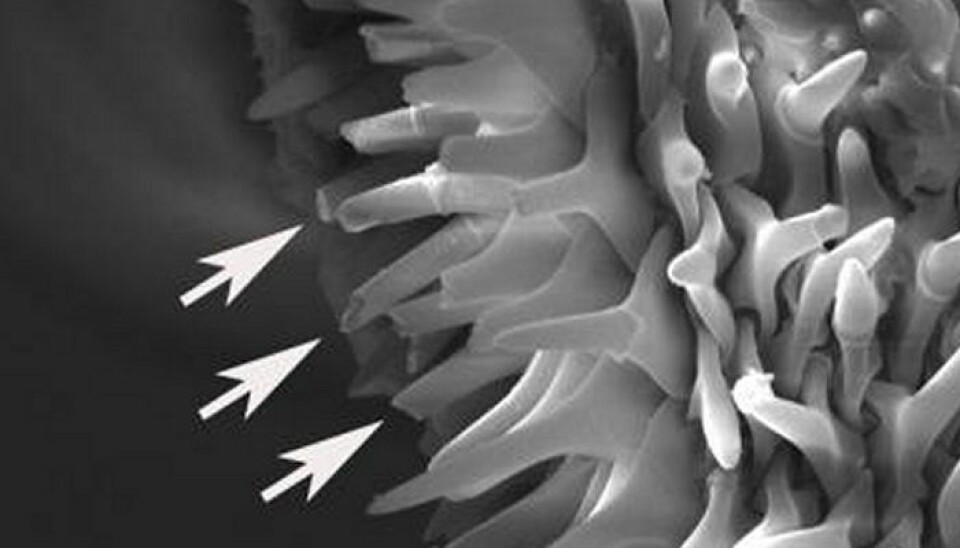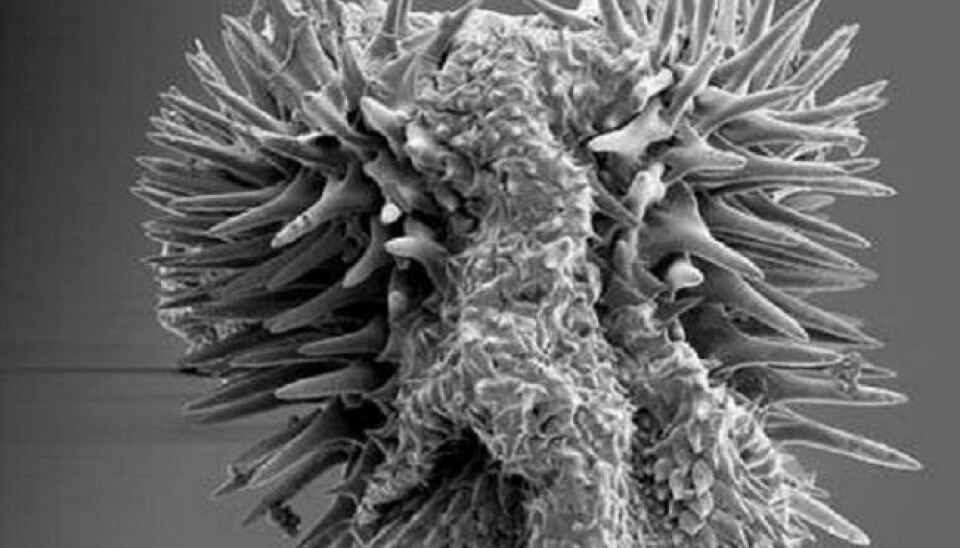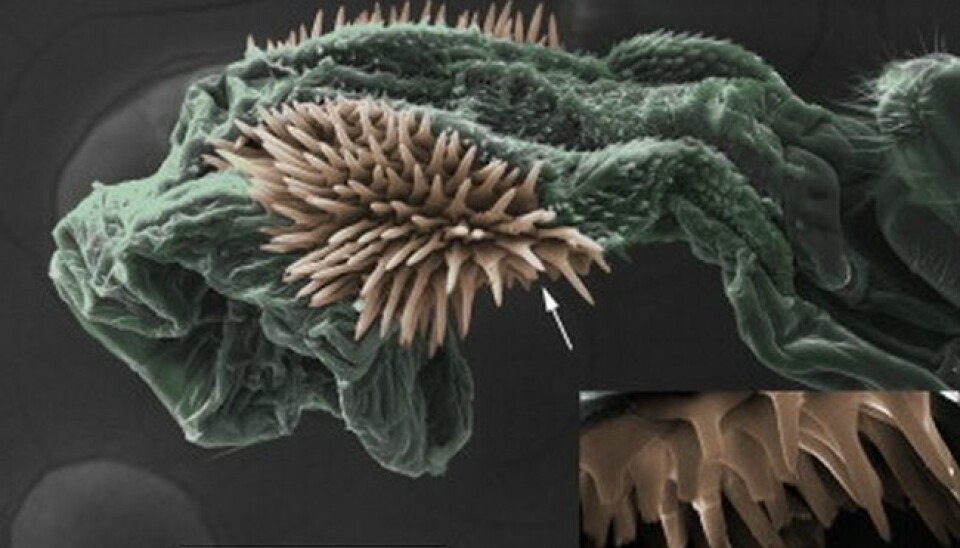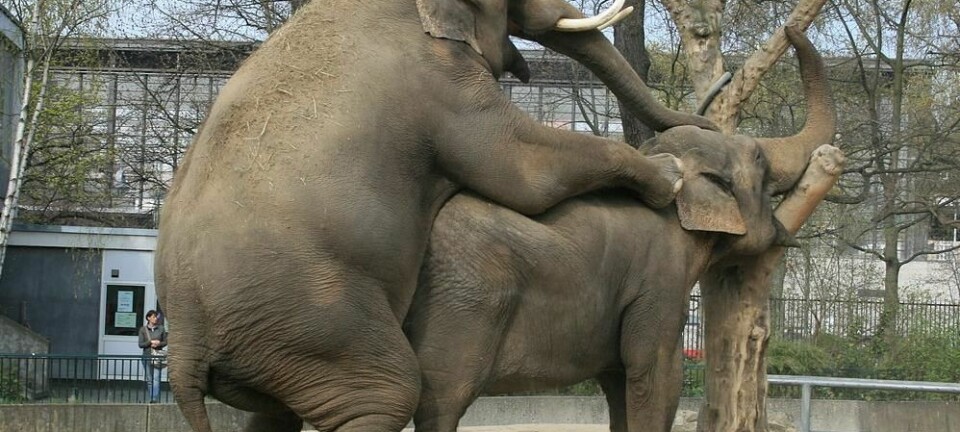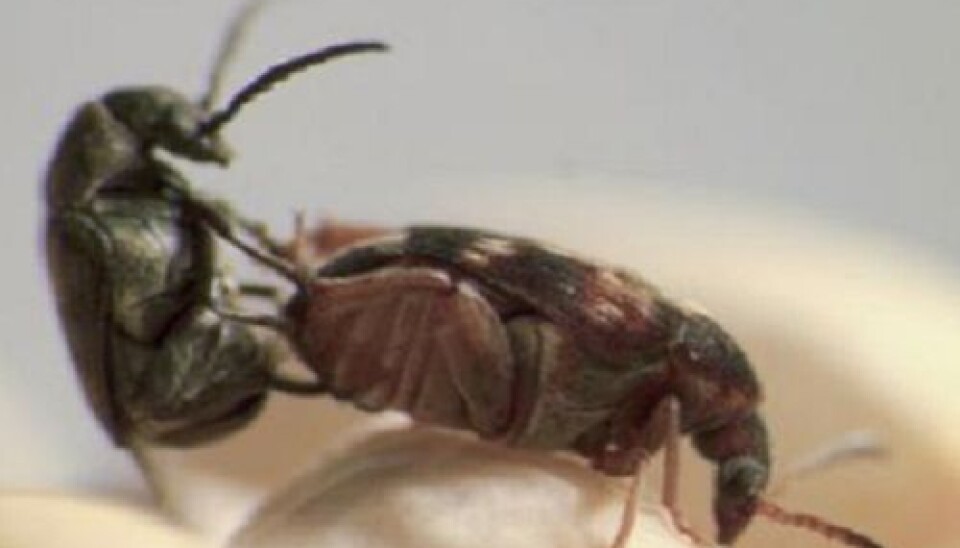
Bizarre penis shaved by scientists
The most terrifying penis in the animal kingdom has now been under the laser. Here, scientists found the answer to an evolutionary mystery.
The picture above is not an instrument of torture from the Middle Ages. It’s a picture of what may well be the most disgusting penis in the animal kingdom. Its owner is the male bruchid beetle (Callosobruchus maculatus).
The many spines on the penis are just as nasty, sharp and destructive as they look. And now a Swedish and American study shows that this is all deliberate.
The female beetle has no say in the matter
Armed with a laser, microscope and a penis pump, the researchers shaved spines off the beetles’ anaesthetised penises, and they can now reveal that the longer and more destructive the spines, the more success the male beetle has.
That’s evolutionary success. The female beetle’s reaction doesn’t matter much. Here it’s all about the number of offspring.
This is the first time that anyone demonstrates in an experimental way the phenomenon of sexual selection after mating.
”This is the first time that anyone demonstrates in an experimental way the phenomenon of sexual selection after mating,” Professor Göran Arnqvist says about the new study, which is published in the journal Current Biology.
Sexual selection includes a variety of reproduction styles
Sexual selection is one of nature’s strongest evolutionary driving forces and is known well beyond the world of beetles. The phenomenon is often associated with the peacock’s huge tail, horns, antlers, strong colours, etc. In other words, characteristics that ensure that the male gets sex.
But what Arnqvist specialises in is selection after mating, where sperm from several males compete to fertilise the female’s egg.
From primitive aquatic nematodes to mammals, it’s a very widespread phenomenon which gives rise to a number of inventive tricks:
Evolutionary suicide is a theoretical possibility.
- Sperm that clump together to form a clot
- Sperm that block subsequent suitors’ sperm
- Penises with hooks that enable the male to cling onto the female, enabling longer mating sessions.
- Penises with brushes, which function as a bottle brush and remove sperm from rival males.
Different sex organs give varied sex
The list goes on and includes extremes where:
- The penis breaks inside the female
- Sperm with chemical weapons makes the next suitor virtually impotent
- An ejaculation can be so powerful that the female is flushed free of foreign sperm.
For centuries, scientists have wondered about this great variation in male sex organs in a wide range of animals, and why this particular part of the body has evolved so quickly.
Many closely-related species can only be distinguished by the shape of the penis.
But how come teeth, limbs, brains or the body shape don’t evolve as quickly?
”It’s a truly basic, widespread and important evolutionary pattern,” says Arnqvist.
”Only in the past 10-20 years have we started to realise that it’s probably due to sexual selection in the male sex organs.”
A long penis makes good sense
When you think about it, it makes good sense that the penis is longer, so that the sperm is delivered nearer to the eggs, or that the amount of sperm is high.
But this phenomenon is actually very difficult to get hard experimental facts on – because how do you isolate characteristics in for instance a penis and study their effect individually?
This is where the bruchid beetle enters the picture.
Beetle exposed to penis pump and laser
In 2009, Arnqvist and his colleague Cosima Hotzy anaesthetised male beetles from 13 countries and measured the length of their penis spines. They found that the males with the longest spines on their penises fertilise the most eggs and get the most offspring.
But it remained unclear why this was so, and there could theoretically be other hidden factors at play.
In the new study, the biologists have therefore manipulated the penises directly. They have bred males with shorter penis spines, and on some of the beetles, they shortened the spines themselves using lasers.
The latter is a complex procedure in which the male beetle is anaesthetised with carbon dioxide. The researchers used a penis pump – a thin pipette tip with a small air hose – to inflate the penis. They then used a microscope to help them burn off spines individually with a precision laser.
The longest penis spines are most important
The male beetles were given a few days to recover, and then they were allowed to mate with females again. And again the researchers found that the males with the longest spines on their penises get the most offspring, independent of other factors such as body size.
Both groups of males produced the same result, and thus the theory of sexual selection after mating has been documented experimentally.
But the researchers are taking it one step further.
Manipulate the female via the blood
By dissecting the females after mating, the researchers could clearly see that the long spines cause severe damage and tear bleeding holes inside the female.
But why evolve such a cruel penis that hurts the female? It doesn’t appear to have much of an evolutionary advantage, yet the female beetles, strange as it may sound, are ready to mate again before a full day has passed.
The scientists tagged the sperm using a mildly radioactive chemical. This enabled them to demonstrate that up to 40 percent of the male’s seminal fluids flow out of the female’s genital tract and into the bloodstream.
And the longer the spines, the more of the male’s body fluids flow into the female’s blood.
Here, naturally, the sperm does not fertilise any eggs, so “it points to a rather complex mechanism,” says Arnqvist.
For bruchid beetles, and many other animals too, the sperm normally doesn’t travel directly to the eggs. Rather, they are kept in special pockets, from which the eggs are then fertilised.
This pocket typically contains sperm from many males, and Arnqvist’s idea is that the spines open the gates to the bloodstream for factors that make the female take more of the sperm into the sperm pocket.
So further studies of the beetle’s nasty penis are needed to identify which factors are included in the ejaculate, and how they function.
Violent penis could lead to evolutionary suicide
If you’re wondering whether the female simply puts up with this horrific piece of genital terror, the answer is that she would, all other things being equal, certainly be better off if the male did not use his spines.
The female has also developed additional connective tissue in her genital tract, which provides partial protection. And, not surprisingly, she does her best to make the intercourse as short as possible by kicking the male.
But the terrifying penis is here to stay.
“There’s no selection for gentler males,” says the Swedish professor.
”A gentler male wouldn’t really get his genes spread to future generations because he would have lower fertilisation success.”
Ultimately, it is conceivable that the penis could evolve to become so damaging to the female that it could threaten the entire population or even the whole species.
“Evolutionary suicide is a theoretical possibility,” says Arnqvist.
----------------------------------------
Read the Danish version of this article at videnskab.dk
Translated by: Dann Vinther
